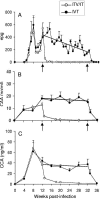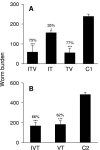Previous or ongoing schistosome infections do not compromise the efficacy of the attenuated cercaria vaccine
- PMID: 16790771
- PMCID: PMC1489735
- DOI: 10.1128/IAI.01657-05
Previous or ongoing schistosome infections do not compromise the efficacy of the attenuated cercaria vaccine
Abstract
A current or previous schistosome infection might compromise the efficacy of a schistosome vaccine administered to humans. We have therefore investigated the influence of infection on vaccination, using the baboon as the model host and irradiated Schistosoma mansoni cercariae as the vaccine. Protection, determined from worm burdens in test and controls, was not diminished when vaccination was superimposed on a chronic infection, nor was it diminished when it followed a primary infection terminated by chemotherapy. Protection was also assessed indirectly based on fecal egg output and circulating antigen levels, as would be the case in human vaccine trials. In almost all instances, these methods overestimated protection, sometimes with discrepancies of >20%. The overwhelming immune response to egg deposition in infected animals made it difficult to discern a contribution from vaccination. Nevertheless, the well-documented immunomodulation of immune responses that follows egg deposition did not appear to impede the protective mechanisms elicited by vaccination with attenuated cercariae.
Figures





Similar articles
-
Optimal vaccination against Schistosoma mansoni requires the induction of both B cell- and IFN-gamma-dependent effector mechanisms.J Immunol. 1999 Jan 1;162(1):345-51. J Immunol. 1999. PMID: 9886405
-
Protective immunity in baboons vaccinated with a recombinant antigen or radiation-attenuated cercariae of Schistosoma mansoni is antibody-dependent.J Immunol. 1993 Nov 1;151(9):4782-9. J Immunol. 1993. PMID: 8409436
-
Schistosome vaccine testing: lessons from the baboon model.Mem Inst Oswaldo Cruz. 2006 Sep;101 Suppl 1:369-72. doi: 10.1590/s0074-02762006000900061. Mem Inst Oswaldo Cruz. 2006. PMID: 17308800
-
Resistance to re-infection after exposure to normal and attenuated schistosome parasites in the baboon model.Parasite Immunol. 2005 Jul-Aug;27(7-8):281-8. doi: 10.1111/j.1365-3024.2005.00783.x. Parasite Immunol. 2005. PMID: 16138849 Review.
-
Immunity induced by the radiation-attenuated schistosome vaccine.Parasite Immunol. 2005 Jul-Aug;27(7-8):271-80. doi: 10.1111/j.1365-3024.2005.00764.x. Parasite Immunol. 2005. PMID: 16138848 Review.
Cited by
-
Protective Potential of Antioxidant Enzymes as Vaccines for Schistosomiasis in a Non-Human Primate Model.Front Immunol. 2015 Jun 2;6:273. doi: 10.3389/fimmu.2015.00273. eCollection 2015. Front Immunol. 2015. PMID: 26082781 Free PMC article.
-
Tools for diagnosis, monitoring and screening of Schistosoma infections utilizing lateral-flow based assays and upconverting phosphor labels.Parasitology. 2014 Dec;141(14):1841-55. doi: 10.1017/S0031182014000626. Epub 2014 Jun 16. Parasitology. 2014. PMID: 24932595 Free PMC article. Review.
-
Experimental vaccines in animal models for schistosomiasis.Parasitol Res. 2008 Apr;102(5):825-33. doi: 10.1007/s00436-008-0887-6. Epub 2008 Feb 8. Parasitol Res. 2008. PMID: 18259777 Review.
-
Models of Protective Immunity against Schistosomes: Implications for Vaccine Development.Pathogens. 2023 Oct 3;12(10):1215. doi: 10.3390/pathogens12101215. Pathogens. 2023. PMID: 37887731 Free PMC article. Review.
-
Rhesus macaques self-curing from a schistosome infection can display complete immunity to challenge.Nat Commun. 2021 Oct 26;12(1):6181. doi: 10.1038/s41467-021-26497-0. Nat Commun. 2021. PMID: 34702841 Free PMC article.
References
-
- Ashton, P. D., R. S. Curwen, and R. A. Wilson. 2001. Linking proteome and genome: how to identify parasite proteins. Trends Parasitol. 17:198-202. - PubMed
-
- Butterworth, A. E., P. R. Dalton, D. W. Dunne, M. Mugambi, J. H. Ouma, B. A. Richardson, T. K. Siongok, and R. F. Sturrock. 1984. Immunity after treatment of human schistosomiasis mansoni. I. Study design, pretreatment observations, and the results of treatment. Trans. R. Soc. Trop. Med. Hyg. 78:108-123. - PubMed
-
- Coulson, P. S. 1997. The radiation-attenuated vaccine against schistosomes in animal models: paradigm for a human vaccine? Adv. Parasitol. 39:271-336. - PubMed
-
- Curwen, R. S., P. D. Ashton, D. A. Johnston, and R. A. Wilson. 2004. The Schistosoma mansoni soluble proteome: a comparison across four life-cycle stages. Mol. Biochem. Parasitol. 138:57-66. - PubMed
Publication types
MeSH terms
Substances
LinkOut - more resources
Full Text Sources

